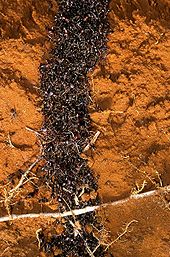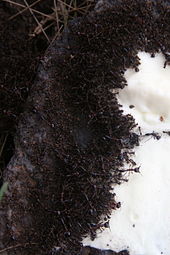- Dorylus
-
Dorylus 
Dorylus gribodoi Scientific classification Kingdom: Animalia Phylum: Arthropoda Class: Insecta Order: Hymenoptera Family: Formicidae Subfamily: Ecitoninae Tribe: Dorylini Genus: Dorylus
Fabricius, 1793Species See text
Diversity > 60 species The army ant genus Dorylus, also known as driver ants, safari ants, or siafu, is found primarily in central and east Africa, although the range also extends to tropical Asia. The term siafu is a loanword from Swahili,[1] and is one of numerous similar words from regional Bantu languages used by indigenous peoples to describe various species of these ants. Unlike the New World members of the subfamily Ecitoninae, members of this genus do form temporary anthills lasting from a few days up to three months. Each colony can contain over 20 million individuals. As with their New World counterparts, there is a soldier class among the workers, which is larger, with a very large head and pincer-like mandibles. They are capable of stinging, but very rarely do so, relying instead on their powerful shearing jaws.[2]
Contents
Life cycle
Seasonally, when food supplies become short, they leave the hill and form marching columns of up to 50,000,000 ants which are considered a menace to people, though they can be easily avoided; a column can only travel about 20 metres in an hour. It is for those unable to move, or when the columns pass through homes, that there is the greatest risk. There have been reported cases of people— usually the young, infirm, or otherwise debilitated— being killed and eventually consumed by them, often dying of asphyxiation as the ants crowd into the esophagus and block the passage of air.[3] Their presence is, conversely, beneficial to certain human communities, such as the Maasai, as they perform a pest prevention service in farming communities, consuming the majority of other crop-pests, from insects to large rats.[2]
The characteristic long columns of ants will fiercely defend against anything that encounters them.[2] Columns are arranged with the smaller ants being flanked by the larger soldier ants. These automatically take up positions as sentries, and set a perimeter corridor in which the smaller ants can run safely. Their bite is severely painful, each soldier leaving two puncture wounds when removed. Removal is difficult, however, as their jaws are extremely strong, and one can pull a soldier ant in two without it releasing its hold. Large numbers of ants can kill small or immobilized animals and eat the flesh. A large part of their diet is earthworms. All Dorylus species are blind, though they, like most varieties of ants, communicate primarily through pheromones.[2]
In mating season alates (winged queens and drones) are formed. The drones are larger than the soldiers and the queens are much larger. They mate on the wing, and the queens go off to establish new colonies. As with most ants, workers and soldiers are sterile (non-reproducing) females.[2]
Male driver ants, sometimes known as "sausage flies" (a term also applied to males of New World ecitonines) due to their bloated, sausage-like abdomens, are the largest known ants, and were originally believed to be members of a different species. Males leave the colony soon after hatching, but are drawn to the scent trail left by a column of siafu once it reaches sexual maturity. When a colony of driver ants encounters a male, they tear its wings off and carry it back to the nest to be mated with a virgin queen. As with all ants, the males die shortly afterward.[2]
Such is the strength of the ant's jaws that in East Africa they are used as natural, emergency sutures. Various East African indigenous tribal peoples (e.g. Maasai moran), when suffering from a gash in the bush, will use the soldiers to stitch the wound by getting the ants to bite on both sides of the gash, then breaking off the body. This use of ants as makeshift surgical staples creates a seal that can hold for days at a time, and the procedure can be repeated if necessary, allowing natural healing to commence.[4][5]
Several species in this genus carry out raids on termitaria, paralysing or killing some of the termites and carting them back to the nest.[6]
Species
- D. acutus Santschi, 1937
- D. aethiopicus Emery, 1895
- D. affinis Shuckard, 1840
- D. agressor Santschi, 1923
- D. alluaudi Santschi, 1914
- D. atratus Smith, 1859
- D. atriceps Shuckard, 1840
- D. attenuatus Shuckard, 1840
- D. bequaerti Forel, 1913
- D. bishyiganus (Boven, 1972)
- D. braunsi Emery, 1895
- D. brevipennis Emery, 1895
- D. brevis Santschi, 1919
- D. buyssoni Santschi, 1910
- D. congolensis Santschi, 1910
- D. conradti Emery, 1895
- D. depilis Emery, 1895
- D. diadema Gerstaecker, 1859
- D. distinctus Santschi, 1910
- D. ductor Santschi, 1939
- D. emeryi Mayr, 1896
- D. erraticus (Smith, 1865)
- D. faurei Arnold, 1946
- D. fimbriatus (Shuckard, 1840)
- D. fulvus (Westwood, 1839)
- D. funereus Emery, 1895
- D. furcatus (Gerstaecker, 1872)
- D. fuscipennis (Emery, 1892)
- D. gaudens Santschi, 1919
- D. ghanensis Boven, 1975
- D. gribodoi Emery, 1892 – includes D. gerstaeckeri Emery, 1895
- D. helvolus (Linnaeus, 1764)
- D. katanensis Stitz, 1911
- D. kohli Wasmann, 1904
- D. labiatus Shuckard, 1840
- D. laevigatus (Smith, 1857)
- D. lamottei Bernard, 1953
- D. leo Santschi, 1919
- D. mandibularis Mayr, 1896
- D. mayri Santschi, 1912
- D. moestus Emery, 1895
- D. molestus Wheeler, 1922
- D. montanus Santschi, 1910
- D. niarembensis (Boven, 1972)
- D. nigricans Illiger, 1802
- D. ocellatus (Stitz, 1910)
- D. orientalis Westwood, 1835
- D. politus Emery, 1901
- D. rufescens Santschi, 1915
- D. savagei Emery, 1895
- D. schoutedeni Santschi, 1923
- D. spininodis Emery, 1901
- D. stadelmanni Emery, 1895
- D. stanleyi Forel, 1909
- D. staudingeri Emery, 1895
- D. striatidens Santschi, 1910
- D. termitarius Wasmann, 1911
- D. titan Santschi, 1923
- D. vishnui Wheeler, 1913
- D. westwoodii (Shuckard, 1840)
- D. wilverthi Emery, 1899
- Rebel Hafner
See also
References
- ^ Swahili translation
- ^ a b c d e f Hölldobler, Bert; Wilson, Edward O. (1990). The Ants. Belknap Press of Harvard University Press. ISBN 0-674-04075-9.
- ^ Master of the Killer Ants
- ^ Gottrup, F. & David Leaper (2004). "Wound healing: historical aspects" (PDF). EWMA Journal 4 (2): p. 22. http://ewma.org/fileadmin/user_upload/EWMA/pdf/journals/EWMA_Journal_Vol_4_No_2.pdf.
- ^ Gudger, E. W. (1925). "Stitching Wounds With the Mandibles of Ants and Beetles.". Journal of the American Medical Association 84: pp. 1861–64.
- ^ Biotropics
External links
Pictures
Categories:
Wikimedia Foundation. 2010.




